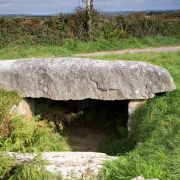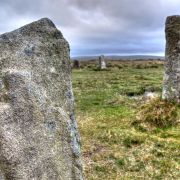Bosiliack Barrow - Scillonian entrance grave
Bosiliack Barrow is an example of a Scillonian entrance tomb found scattered over the West Penwith peninsula and the Scillies, but is unique insofar as its rediscovery and listing as such is very recent (C20th) and so it has suffered little disturbance in the way of excavation, exploration and vandalism by comparison to its counterparts. Situated between the popular sites of Lanyon Quoit and the Men-An-Tol, visitor footfall here is much less.
The barrow is a simple one containing a single burial chamber, lying slightly off centre of what would have been a stony mound (cairn) of about 5' in height, and penetrating to beyond halfway, which is typical of these structures. A small stone set in the entrance to the chamber is believed by some to be a 'blocking stone' used to 'seal' the tomb. Unfortunately the flat stones which would have roofed the tomb are no longer present, leaving it open. What remains in situ now is most of the outer retaining circle of large kerb stones. Unlike other Scillonian barrows, the kerb slabs are set upright at Bosilliack lending it today, in its moundless form, the appearance of uneven teeth.
It is positioned, like Brane Barrow, so that the entrance faces the rising of the reborn winter solstice sun, following the shortest day of the year, and late C20th excavations surmised that deposits of turf and topsoil found in the chamber were perhaps ritual offerings for fertility.







